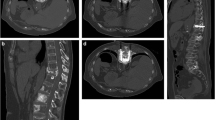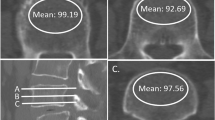Abstract
Objective
The objective was to evaluate percutaneous computed tomography (CT) and fluoroscopy-guided injection of bone cement for consolidation of loosened posterior arthrodesis performed by radiologists.
Methods
A single-centre prospective study involving four consecutive patients (three women, one man) suffering from screw loosening (three at the vertebral level, one at the iliac wing level) after Posterior Lumbar Interbody Fusion (PLIF) treatment was done. The average age was 80 years. Surgical treatment was not indicated or not wished for by the patients. Institutional review board approval and informed consent were obtained. Percutaneous consolidation was performed by an interventional radiologist under CT and fluoroscopy guidance. The path of the trocars was made outside loosened screws bilaterally. Follow-up was assessed using the Visual Analog Scale (VAS).
Results
In all cases, bone cement was successfully placed around the loosened screw. The mean volume of cement that was injected was 3 ml. No cement leakage was observed. No neurological complication occurred. Using VAS, pain decreased from more than 9/10 preoperatively to less than 2/10 the day after the procedure for all patients (p < 0.05).
Conclusion
This study suggests that loosening of spine arthrodesis could be successfully treated by percutaneous injection of bone cement under CT and fluoroscopy guidance.
Key Points
• PLIF is one of the surgical techniques for spinal arthrodesis.
• Treatment indications are degenerative disease or instability following trauma, tumour, or infection.
• Screw loosening is a frequent complication that can occur after surgery.
• Percutaneous facet consolidation under dual guidance seems to be a feasible technique.
• The procedure is performed under local anaesthesia using a minimally invasive approach.





Similar content being viewed by others
Abbreviations
- PLIF:
-
posterior lumbar interbody fusion
- VAS:
-
visual analogue scale
- CT:
-
computed tomography
References
Mummanemi PV, Haid RW, Rodts GE (2004) Lumbar interbody fusion: state-of-the-art, technical advances Invited submission from the joint section meeting on disorders of the spine and peripheral nerves. March 2004. J Neurosurg Spine 1:24–30
Starkweather A (2006) Posterior lumbar interbody fusion: an old concept with new techniques. J Neurosci Nurs 38:13–20
Vaziri K, Brody F, Yu W (2006) Surgical treatment of Pott’s disease. J Am Coll Surg 203:252
Cole CD, McCall TD, Schmidt MH, Dailey AT (2009) Comparison of low back fusion techniques: transforaminal lumbar interbody fusion (TLIF) or posterior lumbar interbody fusion (PLIF) approaches. Curr Rev Musculoskeletal Med 2(2):118–126
Young PM, Berquist TH, Bancroft LW, Peterson JJ (2007) Complications of spinal instrumentation. Radiographics 27:775–789
Okuyama K, Abe E, Suzuki T (2001) Influence of bone mineral density on pedicle screw fixation: a study of pediclescrew fixation augmenting posterior lumbar interbody fusion in elderly patients. Spine J 1(6):402–407
Puri AS, Erdem E (2010) Salvage percutaneous vertebral augmentation in failed spinal interbody fusions associated with multiple myeloma. Spine J 10(8):e5–e10
Moon E, Tam M, Kikano R, Karuppasamy K (2010) Prophylactic antibiotic guidelines in modern interventional radiology practice; Semin Intervent. Radiology 27:327–337
Liu D, Wu Z, Fu S, Gao M (2011) Biomechanical comparison of different techniques in primary spinal surgery in osteoporotic lumbar vertebrae: expansive pedicle screw versus PMMA-augmented pedicle screw. Orth and Trauma Surgery 131(9):1227–1232
Law M, Tencer AF, Anderson PA (1993) Caudo-Cephalad loading of pedicle screw : mechanism of loosening and methods of augmentation. Spine
Turner A, Gillies RM, Svehla MJ, Saito M, Walsh WR (2003) Hydroxyapatite composite resin cement augmentation of pedicle screw fixation. Curr Orth Practice 406(1):253–261
Acknowledgements
The scientific guarantor of this publication is Pauline Foti. The authors of this manuscript declare no relationships with any companies, whose products or services may be related to the subject matter of the article. The authors state that this work has not received any funding. No complex statistical methods were necessary for this paper. Institutional Review Board approval was obtained. Written informed consent was obtained from all subjects (patients) in this study. Methodology: prospective, observational, performed at one institution.
Author information
Authors and Affiliations
Corresponding author
Rights and permissions
About this article
Cite this article
Amoretti, N., Bertrand, AS., Gallo, G. et al. Percutaneous consolidation of loosened spine arthrodesis under CT and fluoroscopy guidance by radiologists: a new useful technique. Eur Radiol 25, 1135–1139 (2015). https://doi.org/10.1007/s00330-014-3475-4
Received:
Accepted:
Published:
Issue Date:
DOI: https://doi.org/10.1007/s00330-014-3475-4




